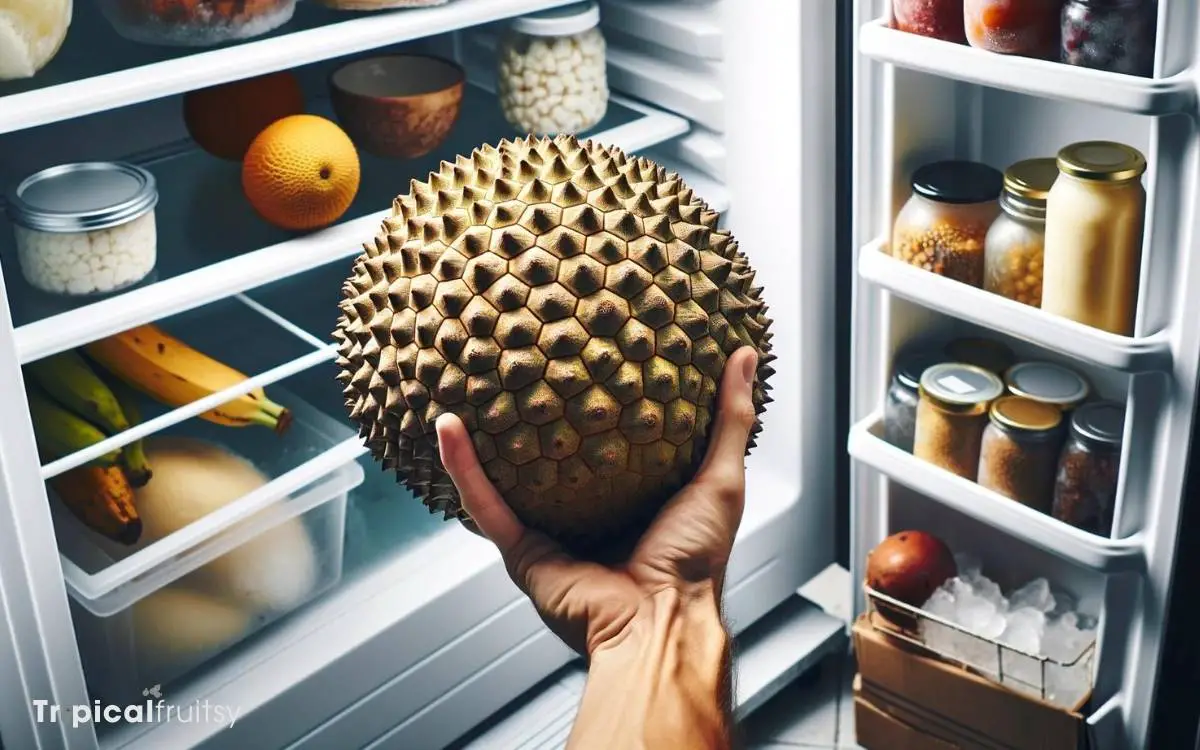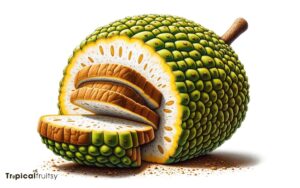Can You Freeze Raw Breadfruit? Step-by-Step Guide!
Yes, you can freeze raw breadfruit to extend its shelf-life. By following proper preparation and storage techniques, frozen breadfruit can retain its quality and be enjoyed out of season.
Freezing raw breadfruit requires specific steps:
Preserve the tropical flavors by freezing breadfruit using these effective methods for long-term storage.

Key Takeaway
Understanding Breadfruit

Before exploring the viability of freezing raw breadfruit, it is crucial to grasp breadfruit’s unique characteristics and culinary uses.
Breadfruit, or Artocarpus altilis, is a tropical fruit related to jackfruit and mulberries, recognized for its starchy texture and high nutrient content.
Its flesh, which can vary from creamy white to yellow, becomes custard-like when cooked, and it is often utilized as a vegetable in various culinary contexts.
Due to its versatility, breadfruit can be roasted, baked, fried, or boiled. The fruit’s composition includes a complex mix of carbohydrates, dietary fiber, and vitamins, making it an integral part of diets in the Pacific Islands, the Caribbean, and parts of Africa and Asia.
Understanding these properties informs the methodology for its preservation, including freezing.
Benefits of Freezing

Freezing raw breadfruit effectively extends its shelf life, allowing consumers to enjoy its unique taste and nutritional benefits well beyond its natural ripening period.
This method of preservation is instrumental in mitigating food waste, as it offers a practical solution for surplus produce that might otherwise perish.
Moreover, the retention of freshness through freezing ensures that the breadfruit maintains a quality that is comparable to its fresh counterpart when later thawed and prepared.
Preserves Freshness
Storing raw breadfruit in a frozen state significantly extends its shelf life while maintaining the fruit’s nutritional value and taste.
Freezing serves as an efficient method for preserving breadfruit’s freshness by halting the enzymatic processes that lead to spoilage.
The cryogenic environment of a freezer ensures that the breadfruit’s cellular integrity is largely preserved, minimizing nutrient loss and flavor degradation.
To elucidate this preservation method, consider the following table:
| Aspect of Freshness | Refrigeration | Freezing |
|---|---|---|
| Shelf Life | Several days | Months |
| Nutrient Retention | Moderate | High |
| Taste Preservation | Limited | Extended |
| Texture Maintenance | Variable | Good |
| Convenience | Low | High |
Freezing not only maintains freshness for a prolonged period but also ensures a high retention of the breadfruit’s original taste and nutritional content.
Reduces Food Waste
Implementing freezing methods for raw breadfruit is a practical strategy for mitigating food waste, allowing consumers and producers to extend the usability of this tropical staple.
By harnessing cold preservation, the window of consumption is significantly broadened, curtailing the urgency to utilize the fruit immediately upon ripening.
Efficiently managing inventory through freezing can dramatically reduce the volume of breadfruit discarded due to spoilage. This practice not only conserves the resources invested in cultivation but also optimizes food availability.
Furthermore, freezing raw breadfruit aligns with sustainability efforts by promoting responsible usage patterns. It ensures the fruit’s benefits are maximized, contributing to food security while minimizing environmental impact.
Turning to the next phase of preservation, proper pre-freeze preparation is essential for maintaining breadfruit’s quality post-thaw.
Pre-Freeze Preparation

Proper pre-freeze preparation of breadfruit is critical for maintaining its quality and texture.
The first step involves thorough cleaning of the skin to remove any dirt or contaminants that could affect the fruit’s flavor or safety.
Subsequently, the application of appropriate slicing techniques is necessary to ensure uniform freezing and to facilitate ease of use post-thawing.
Cleaning Breadfruit Skin
Before freezing raw breadfruit, it is essential to thoroughly cleanse the skin of any dirt or debris to ensure the fruit’s integrity and safety for future consumption.
Commence by inspecting the breadfruit’s surface for visible impurities. Utilize a soft-bristled brush under running water to meticulously scrub the skin, which may harbor microorganisms detrimental to both the fruit’s quality and health standards.
It is advisable to avoid harsh detergents that may penetrate the porous skin, opting instead for food-grade cleansers if necessary.
After the scrubbing process, rinse the breadfruit thoroughly to remove any residual cleaning agent. Patting the fruit dry with a clean cloth is critical to prevent ice crystal formation during freezing, which can compromise texture.
This preparatory step segues into the critical process of slicing the breadfruit for freezing.
Slicing Techniques
After thoroughly cleaning the breadfruit, proceed to cut the fruit into uniform slices, ensuring they are of even thickness for optimal freezing results.
Use a sharp knife to minimize cell damage and preserve the texture of the breadfruit. Analyze the fruit’s size to determine the appropriate thickness for each slice—typically, a range of one-half to one inch is recommended.
Precise slicing not only aids in uniform freezing but also ensures that the pieces will thaw at the same rate, which is crucial for maintaining quality and consistency in texture upon defrosting.
Methodically arrange the slices on a baking sheet lined with parchment paper to prevent sticking and to facilitate an easier transfer into storage containers or freezer bags. This systematic approach sets the stage for the subsequent step-by-step freezing guide.
Step-by-Step Freezing Guide

To successfully freeze raw breadfruit, begin by selecting fully mature, undamaged fruits. This ensures that the quality of the breadfruit remains high after thawing.
Here is a methodical guide to freezing raw breadfruit:
- Wash and Dry: Thoroughly rinse the breadfruit to remove any surface dirt or contaminants. Pat dry with a clean towel to minimize ice crystal formation during freezing.
- Peel and Core: Remove the skin and core of the breadfruit, as these parts do not freeze well and can affect texture.
- Cut into Sections: Slice the breadfruit into uniform pieces to ensure even freezing. Smaller sections freeze faster, reducing the risk of texture changes.
- Pre-Freeze: Lay the sections on a baking sheet lined with parchment paper. Freeze until solid to prevent the pieces from sticking together in storage.
Packaging for Optimal Freshness

How should one package raw breadfruit to maintain optimal freshness during freezing? The methodology for packaging is critical in preserving the quality and taste of breadfruit.
Initially, the fruit should be peeled and sectioned to facilitate uniform freezing and storage convenience.
Each section should then be wrapped tightly in cling film to prevent air exposure, which can lead to freezer burn and spoilage.
| Material | Purpose |
|---|---|
| Cling Film | Creates an airtight seal around the fruit. |
| Freezer Bags | Offers a second layer of protection against contamination. |
| Label & Date | Ensures proper inventory management and rotation. |
| Straw | Optional to remove excess air from freezer bags. |
Employing this meticulous approach will significantly extend the breadfruit’s shelf-life in a frozen state.
Thawing Process Explained

One must carefully manage the thawing of frozen breadfruit to preserve its texture and flavor. An analytical approach to thawing is essential for maintaining the food’s integrity.
Here is a precise method:
- Transfer the frozen breadfruit from the freezer to the refrigerator, allowing for a gradual thaw over several hours or overnight.
- Avoid exposing the breadfruit to room temperature prematurely, which may lead to uneven thawing and textural degradation.
- For quicker thawing, submerge the breadfruit in cold water, changing the water every 30 minutes to maintain a consistent temperature.
- Do not use a microwave or warm water, as this can cause partial cooking, altering the fruit’s cellular structure.
Thoroughly understanding this process sets the stage for evaluating the impact on taste and texture post-thaw.
Impact on Taste and Texture

Upon thawing, the previously frozen raw breadfruit may exhibit subtle changes in taste and a noticeable alteration in texture.
The cryogenic preservation process can lead to a modification in the fruit’s cellular structure, which, upon reconstitution, may not fully return to its pre-frozen state.
This structural change often results in a softer consistency, which can affect the fruit’s mouthfeel and its culinary versatility.
The flavor profile, while largely retained, may have a diminished vibrancy, as the freezing process can dull the natural subtleties of the breadfruit.
To assess the extent of these modifications, a systematic analysis of texture and flavor post-thaw is recommended.
This will provide a baseline for understanding how to best utilize the thawed breadfruit in various recipes, a topic to be further explored in the following section on ‘tips for using frozen breadfruit’.
Can you Freeze Breadfruit without Cooking It First?
Yes, you can freeze breadfruit without cooking it first. To cook frozen breadfruit, easy steps include defrosting it, then boiling or roasting until tender. Enjoy the convenience of having prepared breadfruit on hand for various dishes.
Tips for Using Frozen Breadfruit

Typically, chefs recommend incorporating frozen breadfruit into cooked dishes to mitigate the textural changes caused by freezing.
When utilizing frozen breadfruit, it is crucial to understand how its altered state interacts with other ingredients and cooking methods.
The following list delineates guidelines for harnessing the potential of frozen breadfruit in culinary applications:
- Thaw breadfruit partially to facilitate easier peeling and cutting, maintaining a firmer texture for subsequent cooking.
- Incorporate into stews or curries, where the fruit can absorb flavors while contributing to the dish’s hearty consistency.
- Use in baked goods like breads or muffins, where pureed breadfruit can add moisture and a subtle, sweet flavor profile.
- Avoid using thawed breadfruit in applications where its raw texture is paramount, such as in fresh salads or salsas.
Conclusion
Freezing breadfruit is a viable method for extending its shelf life and preserving its nutritional value.
With proper preparation and storage techniques, breadfruit can maintain its quality for several months.
The process may slightly alter its taste and texture, but it remains a nutritious and versatile ingredient.
A study indicates that frozen breadfruit retains over 90% of its original vitamin C content, making it a compelling option for those looking to minimize waste and ensure year-round availability.






